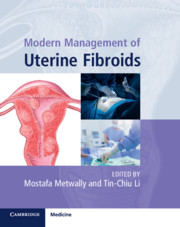Book contents
- Modern Management of Uterine Fibroids
- Modern Management of Uterine Fibroids
- Copyright page
- Contents
- Contributors
- Foreword
- Chapter 1 Pathophysiology of Uterine Fibroids
- Chapter 2 Evaluation of Uterine Fibroids Using Two-Dimensional and Three-Dimensional Ultrasonography
- Chapter 3 Ulipristal and Other Medical Interventions for Treatment of Uterine Fibroids
- Chapter 4 The Role of Magnetic Resonance Imaging in the Management of Fibroids
- Chapter 5 Fibroids and Fertility
- Chapter 6 Fibroids and Reproduction
- Chapter 7 Open Myomectomy
- Chapter 8 Laparoscopic and Robotic Myomectomy
- Chapter 9 Principles and Technique of Laparoscopic Myomectomy
- Chapter 10 Uterine Fibroids
- Chapter 11 Total Laparoscopic Hysterectomy for the Fibroid Uterus
- Chapter 12 Hysteroscopic Resection of Submucosal Fibroids
- Chapter 13 Modern Management of Intramural Myomas
- Chapter 14 Outpatient Myomectomy
- Chapter 15 Vaginal Hysterectomy with Fibroids
- Chapter 16 Leiomyosarcoma
- Chapter 17 MRI-Guided Ultrasound Lysis of Fibroids
- Chapter 18 Embolization for the Management of Uterine Fibroids
- Chapter 19 Uterine Fibroids in Postmenopausal Women
- Appendix: Video Captions
- Index
- References
Chapter 1 - Pathophysiology of Uterine Fibroids
Published online by Cambridge University Press: 10 October 2020
- Modern Management of Uterine Fibroids
- Modern Management of Uterine Fibroids
- Copyright page
- Contents
- Contributors
- Foreword
- Chapter 1 Pathophysiology of Uterine Fibroids
- Chapter 2 Evaluation of Uterine Fibroids Using Two-Dimensional and Three-Dimensional Ultrasonography
- Chapter 3 Ulipristal and Other Medical Interventions for Treatment of Uterine Fibroids
- Chapter 4 The Role of Magnetic Resonance Imaging in the Management of Fibroids
- Chapter 5 Fibroids and Fertility
- Chapter 6 Fibroids and Reproduction
- Chapter 7 Open Myomectomy
- Chapter 8 Laparoscopic and Robotic Myomectomy
- Chapter 9 Principles and Technique of Laparoscopic Myomectomy
- Chapter 10 Uterine Fibroids
- Chapter 11 Total Laparoscopic Hysterectomy for the Fibroid Uterus
- Chapter 12 Hysteroscopic Resection of Submucosal Fibroids
- Chapter 13 Modern Management of Intramural Myomas
- Chapter 14 Outpatient Myomectomy
- Chapter 15 Vaginal Hysterectomy with Fibroids
- Chapter 16 Leiomyosarcoma
- Chapter 17 MRI-Guided Ultrasound Lysis of Fibroids
- Chapter 18 Embolization for the Management of Uterine Fibroids
- Chapter 19 Uterine Fibroids in Postmenopausal Women
- Appendix: Video Captions
- Index
- References
Summary
Uterine fibroids are a major cause of morbidity in women [1]. Fibroids have variable clinical presentations, depending on size and location. These include pelvic pain (20–40% of patients), bleeding (30% of patients), and anaemia. Fibroids are the leading cause of hysterectomy in the United States [2]. Bleeding from fibroids generally presents as abnormal uterine bleeding (AUB) and often prolonged or heavy menstrual bleeding (HMB) [3]. Fibroids that bleed are more frequently submucosal or extend into the endometrial cavity. Other problems related to fibroids include problems with implantation [1], preterm labour, recurrent loss of pregnancy, obstruction of labour, and urinary incontinence [4]. Medical costs for patients with fibroids in the United States were estimated as 4.1–9.4 billion US dollars in 2010 [2].
- Type
- Chapter
- Information
- Modern Management of Uterine Fibroids , pp. 1 - 13Publisher: Cambridge University PressPrint publication year: 2020



